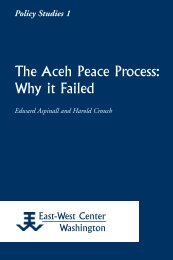Constructing Papuan Nationalism: History, Ethnicity ... - ScholarSpace
Constructing Papuan Nationalism: History, Ethnicity ... - ScholarSpace
Constructing Papuan Nationalism: History, Ethnicity ... - ScholarSpace
- No tags were found...
Create successful ePaper yourself
Turn your PDF publications into a flip-book with our unique Google optimized e-Paper software.
112constructing national identity with specific focus on conflicts rooted in therelationship of minority communities to the nation-state. Here too manyAsian states have made considerable progress in constructing nationalcommunities but several states including some major ones still confrontserious problems that have degenerated into violent conflict. By affectingthe political and territorial integrity of the state as well as the physical, cultural,economic, and political security of individuals and groups, theseconflicts have great potential to affect domestic and international stability.PurposeThe project investigates the dynamics and management of five key internalconflicts in Asia—Aceh and Papua in Indonesia, the Moro conflict inthe southern Philippines, and the conflicts pertaining to Tibet andXinjiang in China. Specifically it investigates the following:1. Why (on what basis), how (in what form), and when does group differentiationand political consciousness emerge?2. What are the specific issues of contention in such conflicts? Are theseof the instrumental or cognitive type? If both, what is the relationshipbetween them? Have the issues of contention altered over time? Arethe conflicts likely to undergo further redefinition?3. When, why, and under what circumstances can such contentions leadto violent conflict? Under what circumstances have they not led toviolent conflict?4. How can the conflicts be managed, settled, and eventually resolved?What are policy choices? Do options such as national self-determination,autonomy, federalism, electoral design, and consociationalismexhaust the list of choices available to meet the aspirations of minoritycommunities? Are there innovative ways of thinking about identityand sovereignty that can meet the aspirations of the minority communitieswithout creating new sovereign nation-states?5. What is the role of the regional and international communities in theprotection of minority communities?6. How and when does a policy choice become relevant?DesignA study group has been organized for each of the five conflicts investigatedin the study. With a principal researcher each, the study groups comprisepractitioners and scholars from the respective Asian countries includ-
















